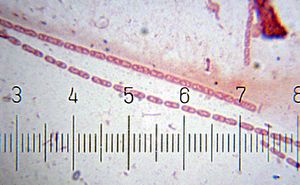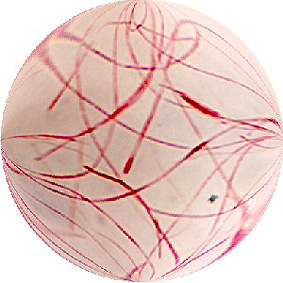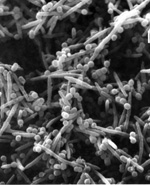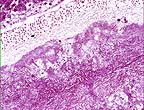Fusobacterium
A Microbial Biorealm page on the genus Fusobacterium

Numbered ticks are 11 µM apart.
Gram-stained.
Photograph by Bob Blaylock.

Classification
Higher order taxa:
Bacteria; Fusobacteria; Fusobacteria (class); Fusobacterales; Fusobacteriaceae
Species:
|
NCBI: Taxonomy Genome: F. nucleatum subsp. n. ATCC 25586 F. nucleatum subsp. vincentii ATCC 49256 |
F. canifelinum; F. equinum; F.genomosp. C1; F. genomosp. C2; F.gonidiaformans; F. mortiferum; F. naviforme; F. necrogenes; F. necrophorum; F. nucleatum; F. nucleatum subsp.; F.perfoetens; F. periodonticum; F. russii; F. simiae; F. ulcerans; F. varium; Fusobacterium sp.
Description and Significance
Fusobacterium is a Gram-negative non-sporeforming bacterium that is widely known and studied as a human and animal pathogen. Fusobacterium's exceptional ability to adhere with both Gram-negative and Gram-positive plaque microorganisms in biofilms (specifically in soft tissue) has made it a highly invasive pathogen. Primarily given attention for its peridontal implications, strains of Fusobacterium have been identified as pathogen to many parts of the body (Weinstock).
Genome Structure
Two genomes have currently been sequenced: Fusboacterium nucleatum subsp. nucleatum ATCC 25586 and Fusobacterium nucleatum subsp. vincentii ATCC 49256. Both of these genomes were sequences by Integreated Genomics. A wealth of knowledge has already been discovered by these first two pioneer sequencings.
Cell Structure and Metabolism
This spindle-shaped or fusiform rod-shaped bacterium varies in size, motility, and form. Fusobacterium cells have been identified both as motile and non-motile.When rod-shaped, Fusobacterium cells have parallel walls wuth rounded or tapered ends (Integrated). Fusobacteriumcells gain energy through fermenting carbohydrates and certain amino acids. This fermentation creates butyrate and in some cases acetic acids as major metabolic by-products (Oral).
Ecology

Fusobacterium inhabit the mucous membranes of humans and animals, serving as a pathogen to both. Because of its pathogenic and parasitic nature, Fusobacterium does not affect the environment directly, but it may alter the ecosystem by its effects on the population of infected host animals.
Pathology

Fusobacterium has several pathogenic strains, such as Fusobacterium nucleatum. F. nucleatum is known for causing typical dental plaque on human teeth as well as involvement in periodontal diseases and invasive human infections of the head and neck, chest, lung, liver and abdomen. The characteristics that make F. nucleatum such an efficient pathogen include its ability to adhere to a large selection of other plaque-causing microorganisms, allowing F. nucleatum to build on the previous biological damage. In addition, F. nucleatum has been documented as highly proficient in its ability to invade and resilient against host tissue cells (Oral).
References
Integrated Genomics. "Fusobacterium nucleatum subsp. nucleatum ATCC 25586."
Oral Microbiology. The University of Adelaide. Dentistry. "Fusobacterium nucleatum."
